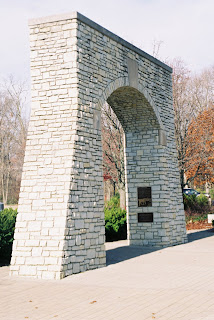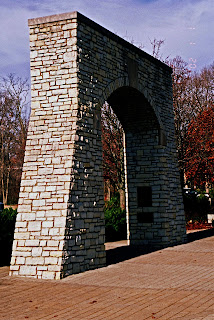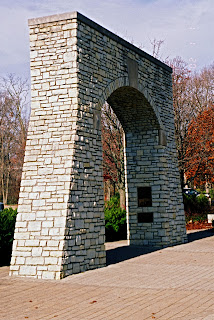Little Black Dog Photo Blog
An Amateur Photo Blog, Featuring Various Pictures Of The Best Dog Ever, Plus Other Stuff.
Tuesday, March 10, 2009
Now that's what I'm talking about!
For the photo geeks that just wandered by, this is one of my favorite subjects, shot with a Nikon N80, el cheapo plastic bodied kit lens, on Fuji Sensia 100 slide film, developed by Cord Camera, and scanned by Costco.
UV filter only, by the way. I'm going to try the shot with a nice Circular Polarizing filter this year, but it's going to be a bit before the background is ready.
Pretty sad that my old film camera and cheapo lens are beating the snot out of anything you can get out of digital, but there it is. Nikon D40? Good for people pictures, lousy for landscapes. Canon 20D? Ditto. Any compact I've ever tried? Don't make me laugh.
Real landscape photographers use film, period.
Sunday, February 01, 2009
Can you hear squealing?

The colors, they are like 130 million little fingers, massaging my brain through my optic nerves, soothing my savage psyche.
Well, plenty, probably. If you've been following Ken Rockwell lately (as you should be) you'll know that he's focusing primarily on film for scenic work, as he should be. Film still beats digital, pwns it mightily, as the youngsters might say, if they were a bit more literate. 35mm actually provides a better image than 24MP digital, provided that it's properly exposed, developed, and scanned low ISO slide film. That's a fairly low res scan, by the by. At 6400dpi, 35mm scans at aproximately 50MP. The 6x45 medium format slide film that provides the images shown here on my page provides an image 2.7 times better than that, and who has a 130MP digital medium format on the market yet?
Nobody, that's who.
Oh, sure, you could spring for the latest Hasselblad, (and don't I wish I could, but I haven't the scratch, Jack) and that would get you closer than you might think, but then you would be out $50,000 or so, while I spent a whopping $425 to get my Fuji GA645 delivered. Toss in another $600 to get Epson's latest Perfection class scanner, and I hate to tell you this, but $48,000 buys a LOT of film, processing and scanning.
Heck, it even buys a REAL medium format system, like the Mamiya 645AF SLR ($500 delivered, with one regular film back, one polaroid film back and an 80mm 2.8 prime), which is going to blow my Fuji out of the water and up on the beach this year. Can you imagine those leaf shots with a polarizing filter? I can, and it's giving me the mother of all warm fuzzies.
The Mamiyah has so many neato keen features I dunno where to start, but this ought to warm the cockles of the hearts of all you tripod hugging types: Mirror up, viewfinder blocker built into the viewfinder and a fully mechanical time mode. And here I thought the top notch glass and TTL capabilities were enough to get excited about...
If you're wondering about the title, by the way, well, my Mamiyah thinks yore DSLR shore has a purty mouth... :)
Watch this space, it's going to be a good year in pictures.
Saturday, October 04, 2008
Holy Snikies!
Adorama is having a sale on Epson V700's! At $399 a pop for the next week, this is best deal imaginable. If you have a ton of old film lying about you need to digitize (and the time to do it) this is the best deal going. If you want to shoot film and get image files that blow digital out of the water and up on the beach, get one. Seriously, go get one of these things. Just remember to buy the www.betterscanning.com film holder for medium format film if you have any. It makes all the difference in the world in your scan quality.
The top shot is Fuji Sensia 400 slide film shot through an N80 with the 28-80 3.5-5.6 G kit lens.
The middle shot is Kodak 200 negative film shot through an N80 with the same lens, this time in the hands of my father.
The lower shot is Fuji Velvia 50 slide film, shot through a Fuji GA645, the king of all medium format point and shoots.
Friday, October 03, 2008
Philosopher Dog
I'm not sure, but I think my little black dog was trying to work out the errors in the old saying "I think, therefore I am". She's a bit of a Randian, but she's trying to go a bit deeper than merely saying that the correct expression is "I am, therefore I will choose to think".
Nikon N80, 28-80 3.5-5.6 G, Fuji Sensia 400.
Slide film, baybee!
The above (click the picture to embiggen) is Fuji Sensia 100, shot with a Nikon N80 35mm through the basic 28-80 3.5-5.6 G "kit lens". As Ken Rockwell likes to point out, that lens is vastly better than it has any right to be. The image was scanned at 6400 dpi on an Epson V700, yielding dimensions of 8864 x 5788 or about 51.3 Megapixels. The temptation here is taunt all the poor suckers that think they have an adequate camera with the Canon 1Ds Mk2 and it's measly 21 Megapixels, but the reality is that they're probably getting somewhat better detail, even if they're not exactly getting the same level of color. All Megapixels are NOT created equal. The Epson had autocorrect, unsharp mask, and digital ICE turned on. Autocorrect did not shift color, but did slightly brighten, which is good, as it indicates that the N80 is very slightly underexposing. As I will touch on further down, this is critical with slide film.
Some notes on slide film, from my own experience.
It's expensive! 36 exposures costs almost as much as a roll of 220, (purchase plus developing cost is almost $20 a roll for both) which yields 30 exposures from my Fuji GA645. This means that I'm getting vastly more bang for my buck from 220, which has at least 2.5 times the area of 35mm, as exposed by the Fuji GA645.
To say that slide film is picky about exposure is to understate the problem by several orders of magnitude. If you're unsure about your lighting, don't use slide film! Indoors without good lighting is a recipe for mediocrity at best. I've tried it, and even on the N80 I'm plagued with a properly lit subject surrounded by wild underexposure, when using the popup flash. I will be purchasing an SB28 at some point and trying a roll of Provia 400 with bounce flash (no fill, darn it), but I'm not really holding my breath that this will be the solution. I may even try my Bowers grip and auxilary optically triggered flash in conjunction with the popup flash to see what I get.
It's worth the money, if I'm doing a certain type of photography. Grain is finer and colors are worlds away better than negatives. What you see above is the type of photography where slide film shines. Outdoors, massive amounts of light, and colorful subjects. The other area I've seen it look good is studio photography. With a tripod and some proper lighting, slide film in the studio still puts a hurting on digital.
There's very little dynamic range. If you notice, the highlights aren't blown, but the shadows are blocked out pretty hard. No, I don't use ND filters, although I probably should, to get the highlights down closer to the shadows. Given that limited dynamic range, it is critical that your camera not overexpose. Like digital, slide film simply clips off when overexposed. Negative film still has quite a bit more shoulder, but then, if you were happy with negative film color you wouldn't be shooting slide fim. The N80 has the best meter I've ever seen, and pretty much nailed it. I have to turn the exposure compensation up on my GA645, as it routinely underexposes. This is fine for slide film, but it blahs out my negative exposures.
Finally, the whole megapixel bit. It's nonsense. 35 mm negative film, properly exposed and scanned, gives a perfectly acceptable 20x30 for consumer use. Would I try to sell such a print professionally? Probably not. Would I hang my own work in my own house at that size? You bet. And slide film is better. It has a tighter grain, thus better detail, and far better color rendering.
To mention Ken Rockwell again, he says he's printed 3 megapixel images at 12 x 18 with good results. This is certainly plausible, but I don't think he understands why. Let me explain.
When you take your digital images to a 1 Hour Photo lab for printing, the images are re-sized somewhere in the process. Usually this occurs at the kiosk order point. This is done there for two reasons: 1) images with more resolution than required are downsized to lower bandwidth and storage demands in the lab, and 2) images with less resolution than optimal are upsized to increase customer satisfaction. Upsizing won't work miracles, but it will make that 3 megapixel image that really shouldn't be printed bigger than 5x7 or 8x10 look acceptable at larger sizes.
To sum up, buy an N80, some slide film and an Epson V700. You won't be disappointed.
Saturday, August 16, 2008
My Fuji GA645 just pwned your DSLR.
Do that with your DSLR. No, seriously. I know what you're thinking: "Well, I can take EV down -2/3, crank up the saturation to max, and blah blah blah, I'm there."
Not quite.
First of all, your DSLR, unless you have a Sigma, is interpolating 2/3 of the color data for every pixel. Secondly, even if you have a Sigma, you're a long long long way away from the resolution I captured with that frame of Velvia 50. How far?
What you're looking at is a Picasa2/Blogger downsize from a 2400dpi scan of 6x4.5 film. Total megapixels is about 20, and every single pixel has full color information. Starting to feel a bit green about the gills about the money you spent on the latest greatest trendiest DSLR? Better grab the upchuck bucket then, cupcake, because I'm about to spread some icing.
If I were going to make a decent sized print (and had the computer to handle the file size) I would scan at 4800dpi, which most people agree is the most one can get out of an Epson V700. Even with the magnificent betterscanning film holder, I don't think I can get much more. (As a quick aside, I'd like to state for the record that Epson's OEM film holders for the V700 are some of the worst garbage ever shipped by anyone, anywhere. The only reason they're not worse is that they didn't actually kill someone when I tried to use them.)
That's an 80 megapixel image.
Not bad for a camera I bought for $400.00 used, eh?
Thanks again to Ken Rockwell, for all the swell articles on things like free full frame digital, medium format film photography, film vs. digital, and why film isn't going away.
Sunday, May 04, 2008
Film still rocks!
See that? I did that with an el cheapo Nikon N80 behind an even more el cheapo 28-80 f3.3-5.6 G lens. You could get the whole kit from www.keh.com for far less than you would pay for a Nikon D3. KEH has so many good old used film cameras they're practically giving them away, at least compared to the prices of digitals. For that matter, they have great prices on used digital cameras, lenses, flashes, you name it, if it has to do with photography, they probably have it cheap. And the local pros I talk to say that KEH's rating system is better and more accurate than other big names like Adorama.
The film was even cheap, Fuji Superia 400, $7.99 for 6 rolls at Costco. That's a buck thirty something a roll of 24, and the camera manages to give me at least 25 on every roll! $3.98 for developing and printing, plus $2.99 for a 300 year archival grade gold CD, and we're home and dropping the 2400 x 3600 images on the hard drive.
YMMV on that last, I understand some other, lesser Costco locations use Noritsu printers, which only scan film at 2000 x 3000. I'm lucky to be near a Costco with a really excellent Fuji printer. The folks there don't do a lot of film, and from what they say, the rest of the processor automatically runs behind the the film scan interface, so they just scan all film to CD orders at "Premium" to give their members better value.
On the other hand, some of the Costco locations have the latest Noritsu's that can print 12 x 36 panorama's, so win some, lose some.
You can't have everything, where would you put it?
Anyway, back to the subject at hand. If you want full frame quality with all it's wonderful advantages, such as better subject isolation at wide apertures and better depth of field due to being able to use tighter apertures before running into diffraction limiting, shoot film and have it scanned by a good lab. Or go to www.costco.com and buy your own film scanner.
Here's Ken Rockwell's original post that encouraged me to continue looking for a decent film camera back when I thought that even a compact digital stomped film, silly me.
John Sevigny agrees.
Bruce Percy weighs in.
If you're going this route, you might consider some filters. I use Hoya's myself, but then, if I find some Tiffens at a decent price, I might have to buy them from now on.
If you're going to get really crazy (and I can feel it coming, like a bad cold), you might consider shooting slide film. Of course, then you might need someone to develop it, as most labs no longer keep the chemistry around. Chrome Digital still does, but you might also find a local pro lab (as opposed to a 1 Hour Lab, they charge more but offer broader and usually better trained services) that will do it for you.
Keep those shutters firing!
Sunday, December 02, 2007
Here's something a little less crazy.
I can't seem to stay away from film
 Unfortunately, I don't own a really good film camera. As you can see, the one I used for this shot used center weighted metering, rendering shadow detail just fine, but blowing out everything else. Yuck. The lens is also not exceptionally sharp. Double yuck.
Unfortunately, I don't own a really good film camera. As you can see, the one I used for this shot used center weighted metering, rendering shadow detail just fine, but blowing out everything else. Yuck. The lens is also not exceptionally sharp. Double yuck. So after I had my local Costco 1 Hour Photo develop, print, and scan me a Premium CD (8x12 inches, or 2400x3600 pixels. You youngsters just think 8.6 megapixels and move on), I put the image in Photoshop for some much needed loving. Here's the result, which I appear to have taken a bit far, but then, how far is too far when you're making art?
So after I had my local Costco 1 Hour Photo develop, print, and scan me a Premium CD (8x12 inches, or 2400x3600 pixels. You youngsters just think 8.6 megapixels and move on), I put the image in Photoshop for some much needed loving. Here's the result, which I appear to have taken a bit far, but then, how far is too far when you're making art?If you're wondering how to do this yourself, you can pick up a Scott Kelby book for the full scoop under "Fixing Overexposed Images", or just follow these simple steps in Photoshop Elements.
Open the image.
Drag background layer onto Create a New Layer Icon.
Change layer blend mode from Normal to Multiply.
Control-J adds new layers if you need more than one. This one has four extra.
If you need half a layer, highlight the top layer and reduce the opacity.
After doing the above, I switched to Quick Fix, bumped the shadows up 25%, knocked the highlights down 25%, increased mid tone contrast 25%, and sharpened it 25%.
I then saved it as a .jpg, which is very important. If you save it as a .psd, it will be about 109MB, vs 6.9MB.
Is it photography?
No, it's art.
Subscribe to:
Posts (Atom)











